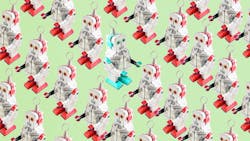Robots were part of our futuristic culture and lore for most of the last century. The idea of machines doing our labor and our thinking is, depending on your point of view, an H.G. Wells flight of fantasy or an Orwellian nightmare.
The science fiction aspect of robotics has faded into the background today. It’s now all science and no fiction. We have robots and cobots and automated guided vehicles whizzing around many manufacturing plants. Behind them is a growing use of artificial intelligence that monitors productivity, safety and machine health.
Robotics and AI together provide a technological opportunity to make work safer and smarter. These concepts offer consumers new ways to get goods more quickly and to be serviced more efficiently. We are on the verge of completely remaking the way humans live and work.
And there are legitimate questions about how far we might take that concept. If the robots are doing the work and AI is doing the thinking, what’s left for the humans? What is our role in the autonomous world we’re building? And what are—and should be—the limits?
We can ask these questions because we possess the things robots and AI have yet to possess: imagination, empathy, curiosity and enthusiasm, among other attributes. As we remake the world we live in, we care about the outcome. There is nothing artificial about our individual intelligence.
Much has been made about Industry 4.0, but it’s worth understanding how we got to the 4.0 part. The steam engine was Industry 1.0—a fundamental change that created mechanization in the manufacturing process. Industry 2.0 was the assembly line, and the rise of computers spawned Industry 3.0.
At every step there was disruption and a fear that we had taken the humans out of the equation. In reality, the humans reimagined their role with this new technology and adapted to change. Long before humans programmed robots, they had become adept at reprogramming themselves.
We must change and adapt, and there’s never been a better test case for change and adaptation than 2020. As we have moved our work lives to a more distanced approach to collaboration, we have quickly found ways to be effective and efficient. We have embraced technology and tried to do so without losing our humanity.
To be sure, it’s been an uneven effort. Not everyone has access to the same technology or the same circumstances. Technology always has been an investment, and those with the foresight or means to take such a risk are the ones ahead of the curve on change. Others get left behind, and catching up almost always is more expensive.
Yet in all the concern over the increasing role of robotics and AI and other technologies such as additive manufacturing, no one really suggests we go back to the days of the steam engine. Progress is a challenge, but a lack of progress has never proven to be beneficial or profitable. So we poke our head around the next corner and see what’s coming.
For us next month, this will take the form of Machine Design’s annual Salary and Career Survey, which will give us a look into the year that has been unlike almost any in our lifetime. There are a few things in this year’s data which reflects that disruption, but for the most part, our engineers and design professionals have kept their eyes on their internal and external goals. There is a true sense that everyone understands the challenges of 2020 will be behind us soon—perhaps not at the turn of a calendar page, but they peer into that future with confidence.
In fact, there’s only one thing engineers want more of, and ironically, it’s the one thing that won’t come from a Congressional edit or an assembly line.
You’ll have to make the time to come back next month.
About the Author

Bob Vavra
Editor Emeritus, Machine Design and Power & Motion
Bob Vavra is the former senior content director of Machine Design and Power & Motion.
